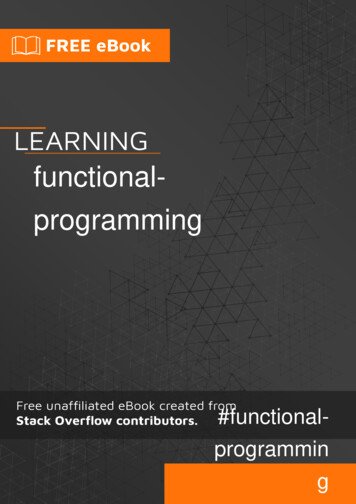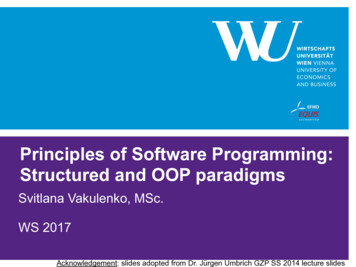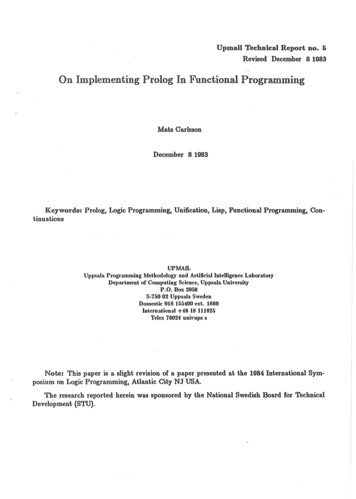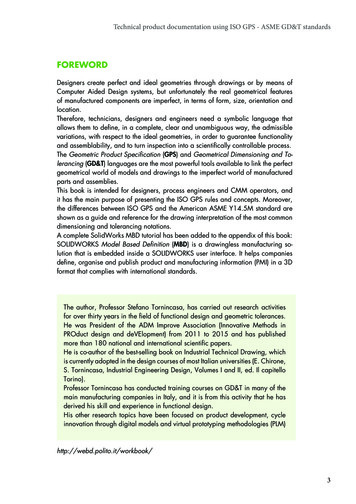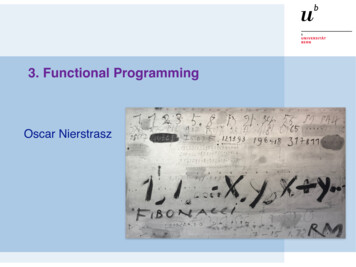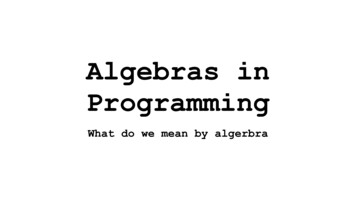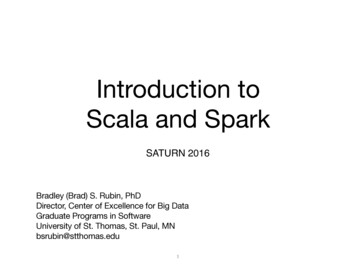
Transcription
Introduction to FunctionalProgramming using F#Chris Lomont, PhDSenior Principal EngineerLogikos Inc. Fort Wayne, omont.org
About me Programming since 4th grade (TI-55!) Soon moved to TRS-80 Color Computer Studied math, CS, physics, economics Worked in too many areas to cover Some: 3D, games, science, DoD, security, algorithms Co-founder of Hypnocube, LLC Functional Programming since Mathematica 1.0 in 1988 Works for Logikos, Inc, Fort Wayne, IN2
About Logikos Software Services Fort Wayne, IN Founded 1978 Areas Embedded Desktop Web Applications and Design Mobile Applications Software Testing Clients Automotive Commercial Services Consumer Electronics Govt and DoD Medical Retail Others3
Talk Purpose Illustrate the power of functional programming Functional programming languages claim to be quicker for development less errors smaller code easily maintainable Illustrate functional programming features via F# .NET4
Talk OverviewI. Functional programming overviewII. F# syntax and examplesIII. Mind-bending topics5
Functional Overview6
Theoretical Foundations The Lambda Calculus Alonzo Church (1903-1995), 1930 “What is computable?” Simplifies math expressions into lambda expressions Church-Turing Thesis Any computation can be done Turing machine Any computation can be done with general recursive functions (in lambda sense) Lambda functions (named from the 𝜆) 𝜆𝑥. 𝑥 1 Means take x as input, output x 1 Called pure functions Have no state Also known as anonymous functionsA very famous lambda functiondefining recursion7
Functional Programming at a High levelFunctionalOO, ImperativeStateless functionsFunctions mutableNo side effectsSide effects everywhereThread safeHard to make thread safeScalableHarder to scaleEasy to testHarder to testComposableNot designed to becomposableHigher order functions(functions as data)Functions and dataseparate Evolved from pure functions Goal: separate pure andimpure parts of programImmutable dataMutable items default(persistent data structures)8
Example: Roslyn C# Compiler C# compiler, written in C# https://github.com/dotnet/roslyn Provides compiler as a service Main data structures are functional programming based Syntax Tree (red-green tree, from maker board colors used) Immutable Persistent – allows keeping most of tree when edit made to buffer ees/9
Example: Design Patterns Gang of Four – 23 patterns “Patterns are simplyworkarounds for C not beingexpressive” - Paul Graham ,2002 Peter Norvig demonstrated 16of the 23 are simplified oreliminated in Lisp or DylanScott Wlaschin10
Functional Programming Languages Functional languages Lisp, Haskell, SML, Clojure, Scala, Erlang, F# Functional with OO features OCaml, F#, Scala“Modern functional languages are nontrivialembellishments of the lambda calculus”– Paul Hudak (1989) Imperative languages with functional features Python, Ruby, C#, Java11
F# Syntax and Features12
What is F#? Statically typed functional firstlanguage Took OCaml and added C# and .NETgluemodule List let rec insertions x function [] - [[x]] (y :: ys) as l - (x::l)::(List.map (fun x - y::x) (insertions x ys))let rec permutations function [] - seq [ [] ] x :: xs - Seq.concat (Seq.map (insertions x) (permutations xs)) Mixed Language Supports Functional, OO, Imperative F# is to C# (CLR) what Scala is to Java(JVM)13
F# History Created by Cambridge MSResearch, led by Don Syme(Benevolent Dictator for Life) Theorem proving ML(Meta Language) Versions 1.0 VS2005, separate download ML CAML CAML OCaml OCaml C# .NET ? F#2.0 VS2010, built in Type Providers4.0 VS2015, built in Active patterns, Units of Measure, async3.0 VS2012, built in Functional, types, modulesprintf interpolation4.1 VS2017, built in Struct tuples, numeric underscores14
F# (and functional) Features Migrating toC# and other languages F# 1.0 implicitly typed locals (var in C# 3.0, auto in C 11, others) F# 1.0 lambda functions added to C# v2.0, C 11, PHP 5.3.0, Delphi 2009 F# 2007 async workflows added to C# 2012 Migrated to many languages since over since Functionals LINQ Expression valued items Pattern matching Tuple construction/deconstruction in C # 7 Expression bodied members Exception filters Auto property initializers Task Parallel Library Non-nullable types (scheduled for C# 8.0?)15
Why Use F#? F# benefits Works well with .NET , easy tointegrate Modern IDE Debugger support Intellisense F# REPL window in VS Power of multicore16
C# vs F# Example 1 C# F#namespace Math{public static class Helpers{public static int Add( int x, int y){return x y;}}}let add x y x y17
C# vs F# Example 2 : Map / Reduce// map / reduce C#public staticIEnumerable R Map T,R (this IEnumerable T xs, Func T,R f){foreach (var x in xs)yield return f(x);}public static R Reduce T,r (this IEnumerable T xs, R init, Func R,T,R f){var current init;foreach (var x in xs)current f(furrent,x);return current;}// map / reduce F#let map f xs seq {for x in xs doyield f x}let reduce f init items let mutable current initfor item in items docurrent - f current itemcurrent18
F# Syntax Comments Variables type inference immutable(* comment between *)// comment to end of line/// XML doc comments herelet result 1 8 // auto type inferencelet s "bob"let pi 3.14159265let b : byte 123 // can specify typelet a, b, c 1.0, "text" , result*419
Lists and Arrays Lists Singly linked Immutable Arrays Fixed size Mutableletletletletletlist1list2list3list4list5 [ "a"; "b" ]"c" :: list1list1 @ list2[]2 :: [3; 5; 7;// :: is prepending// @ is concat// empty list11] @ [13; 17; 19; 23]let array1 [ "a"; "b" ]let first array1.[0] // Indexed using dot// slicinglet tenSquares [ for i in 1.10 - (i,i*i) ]let firstHalf tenSquares.[.5]let secondHalf tenSquares.[6.]let mid tenSquares.[2.6]20
Sequences Sequences Lazy Unbounded Enumerablelet seq1 {1.10}// seq[1;2;3;.;10]let seq2 seq {yield 1// adds elementyield! [5.10] // adds subsequence}21
Range and comprehensions Range Start, stop Step sizelet as [ 5.8 ]// [5;6;7;8]let xs [ 1.2.9 ] // [1;3;5;7;9]let ys [ for i in 0.4 - 2 * i 1 ]let zs List.init 5 (fun i - 2 * i 1) Comprehension Construct list from function22
Tuples Containers for a few things Typed groups of values Trivial to make and deconstruct// Tuple constructionlet wizard ("Merlin",87)// type is string * int// deconstructionlet (name,age) wizard23
Records Named type Sealed Immutable Patterns Structural // Declare a record typetype Person { Name : string; Age : int }// Create a value via record expressionlet paul { Name "Paul"; Age 28 }// 'Copy and update' record expressionlet paulsTwin { paul with Name "Jim" }let isPaul person match person with { Name "Paul" } - true - false24
Functions Are values Type inference Composable// functions return the last item in the functionlet negate x x * -1let square x x * x// functions have typeslet add x y x y // type int - int - intlet add3 add 3// type int - intlet sumSquares x y let sq z z*z // local functionssq x sq y25
Recursive functions Tail recursion List examplelet rec factorial x if x 1 then 1else x * factorial (x - 1)let rec sum list // decompose (::) operatormatch list with // pattern matching [] - 0 x :: xs - x sum xsXKCD #127026
Type inference Generic Automagiclet pack a b (a, b)// type 'a - 'b - 'a * 'b File order in compilation important Deduces types No circular dependencies27
Options option nulls// Built in 'option' widely usedtype 'T option None Some of 'T Prevents ignoring bad return values Compiler forces pattern matching to cover every case28
Pattern Matching Very powerful Switch statement on steroids Complete! Cannot ignore None in an Optionlet checkList lst match lst with [] [e] 1 :: xs :: x :: xs - - - - - printfn "Empty"printfn "One element: %O" e1printfn "Start with 1"printfn "Second element %O" x() // do nothing29
Active Patterns Extend matching programatically(* parameterized active patterns *)let ( DivisibleBy ) by n if n % by 0 then Some DivisibleBy else Nonelet fizzBuzz function DivisibleBy 3 & DivisibleBy 5 - "FizzBuzz" DivisibleBy 3 - "Fizz" DivisibleBy 5 - "Buzz" i - string i30
Discriminated Unions Disjoint unionstype Tree 'T Tree of Tree 'T * 'T * Tree ‘T Leaf of 'Tlet rec depth tree match tree with Tree(l, , r) - 1 max (depth l) (depth r) Leaf( ) - 1let rec size function Tree(l, , r) - 1 size l size r Leaf( ) - 131
Pipeline, partial application, composition Composesfunctions// pipe let square, negate, then print x x square negate printlet sumOfLengths (xs : string []) xs Array.map (fun s - s.Length) Array.sum32
Useful list, array, seq functions Rich set of (mostly) orthogonal helpers find, map, filter, partition, zip, reduce, exists, (* list, seq, array functions *)let prod [1.10] List.fold (*) 1let vals {1.10} Seq.map (fun x- x*x 1)let odds [1.10] List.filter (fun x- (x%1) 0)let (o,e) [1.10] List.partition (fun x- (x%1) 0)let all List.zip odds evens33
Conditionals if/then/else Don’t use ‘if’ Use ‘match’// badlet f xif xthenelse 1"a""b"// goodlet f x match x with 1 - "a" - "b"34
Loops Loops Use recursionor functionsinsteadlet weirdo for i 1 to 49 doprintfn "%d" ilet mutable j 50while j 100 doprintfn "%d" jj - j 135
Exceptions try/with/finally Exceptionfilteringlet divide x y trytry(x 1) / yfinallyprintf "this will always be printed"with :? System.DivideByZeroException as ex - printfn "%s" ex.Message; 036
Classes Inheritance Upcasting Compile time Downcasting Run timetype Animal() member .Rest() ()type Dog() inherit Animal()member .Run() base.Rest()// upcasting : let dog Dog()let animal dog : Animal// downcasting :? let shouldBeADog animal :? Dog37
Example : Quicksortlet rec sort(lst: int list) match lst with []- lst [x]- lst hd:tl - let less,greater List.partition ( ( ) hd ) tl[sort(less)] @ [hd] @ [sort(greater)]38
F# Features : Type Providers Code generation Working cleanly with structured data automatically Hooks into the compiler and IDE Intellisense, code errors Static typing of items in the structure Takes a while to see the power Many existing CSV, HTML, XML, JSON, HTTP, Semantic Web, World Bank, webservices, data markets, much more39
F# Features : Units of Measure Mars climate orbiter fail Failed to translate Englishunits into metric Units of Measure Enforces unit consistency[ Measure ] type degC[ Measure ] type degFlet convertDegCToF c c * 1.8 degF/degC 32.0 degF let f convertDegCToF 0.0 degC // type float degC - float degF 40
Performance F# code performs similarly to C#F# vs C# PerformanceF# vs C# Memory # TimeC# TimeF# MemoryC# Memory From https://benchmarksgame.alioth.debian.org41
Dos and Don’ts Don’t use mutable keywordDon’t use for loops Use recursion insteadDon’t use if then else Use pattern matching insteadDon’t use dot notation Use little functions, pipesDon’t use classes Use tuples, records, unionsDon’t rely on debugger Compiler finds more errors foryou Do create little types Especially unionsDo use list and seq types Learn fold and map well!Eventually replace recursionwith fold Do use pipe Do use composition Do develop incrementally,using interactive window 42
Mind Bending43
Data structures How to make immutable lists? Trees? Example: appendable vector Want to push back, want immutable! Idea: make a new one! (but slow, too much memory!) Solution: Wizardry!44
Data structures Replace vector with tree: But trees 𝑂 log 𝑛 , not 𝑂 1 Use 32-way trees, then𝑂 log 32 𝑛 𝑂(1) More tricks to make faster Local mutable, global immutable No locking, parallelizable45
Currying Converts function of multiple arguments into function of oneargument Then everything can be thought of as a function of one variable Named from Haskell Curry (1900-1982) 𝑥, 𝑦 𝑥 𝑦 curried into 𝑥 (𝑦 𝑥 𝑦) Allows reusing pieces in a much morecomposable manner46
Y-Combinator Functional that recurses any function Discovered by Haskell Curry𝑌 𝜆𝑓. 𝜆𝑥. 𝑓 𝑥 𝑥𝜆𝑥. 𝑓 𝑥 𝑥𝑌𝑔 𝜆𝑓. 𝜆𝑥. 𝑓 𝑥 𝑥 𝜆𝑥. 𝑓 𝑥 𝑥 𝑔 (1) 𝜆𝑥. 𝑔 𝑥 𝑥 𝜆𝑥. 𝑔 𝑥 𝑥(2) 𝑔 𝜆𝑥. 𝑔 𝑥 𝑥 𝜆𝑥. 𝑔 𝑥 𝑥 𝑔 𝑌𝑔 𝑔 𝑌 𝑔 𝑔 𝑔 𝑌 𝑔 𝑔( 𝑔 𝑌 𝑔 )(1) apply function: 𝑓 gets replaced with 𝑔(2) apply first function to second arg: get 𝑔 𝑥 𝑥 with 𝑥 𝜆𝑥. 𝑔 𝑥 𝑥Let’s you write a Y-Combinator function, that recurses on any function fed to it47
Contravariant/Covariant C# uses the concepts of contravariance and covariance How parameters do up/down casting, how assignments work// type relations are an "arrow" : derivedfrom, assignable// allowed, object - stringobject obj "string"// covariance preserves arrows// Allowed: IE obj - IE string IEnumerable object objects List string // ERROR! Disallowed! Cannot do IE obj - IE string IEnumerable string strings List obj // contravariace reverses arrowsAction object objAct function takingobjectAction string strAct funtion taking astring;// Allowed: A obj - A str strAct objAct;// ERROR! Disallowed! Cannot do A obj A string objAct strAct;48
Covariant/ContravariantcatfishIE cat fileanimalIEnumerable T IE fish IE animal objectIE file IE object Covariant preserves arrowscatfishanimalA cat fileAction T A fish A animal objectA file A object Contravariant reverses arrows49
Contravariant/Covariant This leads to the concept of category theory A category is a collection of things with arrows thatcompose IEnumerable and Action are functors functors: map things with arrows to things with arrows Many, many things in programming are functors Understanding some of this gives powerful tools to reasonabout systems“Category theory is type theory” – Abraham Lincoln50
Category Theory Gives large expressive power ifyou build interfaces “correctly” Example: Monoids - set with binaryoperation and unit Integers, , 0 Integers, *, 1 Strings, , “” Lists, concat, [] Generalized . Lots more terms Duality, morphisms, Functors galore Products – simply a pair ofitems Coproducts – the “dual” of aproduct Monads Kliesi arrows Railway Oriented Programming51
Questions?A Bicategory of Decorated Cospans52
Sources and Resources Good talk on F# : https://channel9.msdn.com/blogs/pdc2008/tl11 https://fsharpforfunandprofit.com/ Expert F# 4.0 – Don Syme book Purely Functional Data Structures - Chris Okasaki book Category Theory for Programmers – Bartosz egory-theory-for-programmers-the-preface/ Railway Oriented Programming - Scott railway-oriented-programming Efficient Immutable Data Structures – Tom mies Slide theme from SoftUni Team: http://softuni.bg53
TODO – extra slides Books and sources, Add pics to slides (category stuff) Example translating C# to F# TODO if can find Quick example of reducing C# code to F# by removingunnecessary syntax Books, bring them Data structures example Explain how works (lists, trees, issues)54
Examples : Perfect tic-tac-toeletletletletletletletwins [[1;2;3]; [4;5;6]; [7;8;9]; [1;4;7]; [2;5;8]; [3;6;9]; [1;5;9]; [3;5;7]]Contains number List.exists (fun n - n number)ContainsList list List.forall (fun n - list Contains n)Except list List.filter (fun n - not (list Contains n))Available (p : int list) (o : int list) [1.9] Except (List.append p o)IsWin (squares: int list) wins List.exists (fun w - ContainsList squares w)IsDraw player opponent List.isEmpty (Available player opponent)let rec Score (player: int list) (opponent: int list) if (IsWin player) then 1else if (IsDraw player opponent) then 0elselet opponentsBestMove BestMove opponent playerlet opponentsNewPosition opponentsBestMove::opponent- Score opponentsNewPosition playerand BestMove (player: int list) (opponent: int list) Available player opponent List.maxBy (fun m - Score (m::player) opponent)55
Options Examplelet people ("Adam",("Eve" ,("Cain",("Abel",][None),None),Some("Adam", "Eve")),Some("Adam", "Eve"))let showParents (name, parents) match parents with Some(dad, mom) - printfn "%s dad %s and mom %s" name dad mom None - printfn "%s has no parents" name56
Functional languages Lisp, Haskell, SML, Clojure, Scala, Erlang, F# Functional with OO features OCaml, F#, Scala Imperative languages with functional features Python, Ruby, C#, Java Functional Programming Languages Modern functional languages are nontrivial

